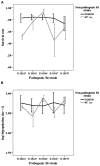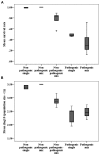Testing GxG interactions between coinfecting microbial parasite genotypes within hosts
- PMID: 24860594
- PMCID: PMC4030146
- DOI: 10.3389/fgene.2014.00124
Testing GxG interactions between coinfecting microbial parasite genotypes within hosts
Abstract
Host-parasite interactions represent one of the strongest selection pressures in nature. They are often governed by genotype-specific (GxG) interactions resulting in host genotypes that differ in resistance and parasite genotypes that differ in virulence depending on the antagonist's genotype. Another type of GxG interactions, which is often neglected but which certainly influences host-parasite interactions, are those between coinfecting parasite genotypes. Mechanistically, within-host parasite interactions may range from competition for limited host resources to cooperation for more efficient host exploitation. The exact type of interaction, i.e., whether competitive or cooperative, is known to affect life-history traits such as virulence. However, the latter has been shown for chosen genotype combinations only, not considering whether the specific genotype combination per se may influence the interaction (i.e., GxG interactions). Here, we want to test for the presence of GxG interactions between coinfections of the bacterium Bacillus thuringiensis infecting the nematode Caenorhabditis elegans by combining two non-pathogenic and five pathogenic strains in all possible ways. Furthermore, we evaluate whether the type of interaction, reflected by the direction of virulence change of multiple compared to single infections, is genotype-specific. Generally, we found no indication for GxG interactions between non-pathogenic and pathogenic bacterial strains, indicating that virulence of pathogenic strains is equally affected by both non-pathogenic strains. Specific genotype combinations, however, differ in the strength of virulence change, indicating that the interaction type between coinfecting parasite strains and thus the virulence mechanism is specific for different genotype combinations. Such interactions are expected to influence host-parasite interactions and to have strong implications for coevolution.
Keywords: Bacillus thuringiensis; Caenorhabditis elegans; GxG; host; multiple infection; parasite; virulence; within-host interaction.
Figures




Similar articles
-
Experimental evolution with a multicellular host causes diversification within and between microbial parasite populations-Differences in emerging phenotypes of two different parasite strains.Evolution. 2017 Sep;71(9):2194-2205. doi: 10.1111/evo.13306. Epub 2017 Aug 16. Evolution. 2017. PMID: 28714591
-
Coinfecting parasites can modify fluctuating selection dynamics in host-parasite coevolution.Ecol Evol. 2020 Aug 30;10(18):9600-9612. doi: 10.1002/ece3.6373. eCollection 2020 Sep. Ecol Evol. 2020. PMID: 33005333 Free PMC article.
-
Within-host competitive interactions as a mechanism for the maintenance of parasite diversity.Philos Trans R Soc Lond B Biol Sci. 2015 Aug 19;370(1675):20140301. doi: 10.1098/rstb.2014.0301. Philos Trans R Soc Lond B Biol Sci. 2015. PMID: 26150667 Free PMC article. Review.
-
Patterns of genotype-specific interactions in an obligate host-specific insect pathogenic fungus.J Evol Biol. 2025 Feb 1;38(2):225-239. doi: 10.1093/jeb/voae149. J Evol Biol. 2025. PMID: 39671697
-
Multiple-genotype infections and their complex effect on virulence.Zoology (Jena). 2016 Aug;119(4):339-49. doi: 10.1016/j.zool.2016.06.003. Epub 2016 Jun 9. Zoology (Jena). 2016. PMID: 27389395 Review.
Cited by
-
Why do insects evolve immune priming? A search for crossroads.Dev Comp Immunol. 2022 Jan;126:104246. doi: 10.1016/j.dci.2021.104246. Epub 2021 Aug 26. Dev Comp Immunol. 2022. PMID: 34453994 Free PMC article. Review.
-
Wolbachia strains wMel and wAlbB differentially affect Aedes aegypti traits related to fecundity.Microbiol Spectr. 2024 Apr 2;12(4):e0012824. doi: 10.1128/spectrum.00128-24. Epub 2024 Mar 14. Microbiol Spectr. 2024. PMID: 38483475 Free PMC article.
-
Interspecies Isobaric Labeling-Based Quantitative Proteomics Reveals Protein Changes in the Ovary of Aedes aegypti Coinfected With ZIKV and Wolbachia.Front Cell Infect Microbiol. 2022 Jul 7;12:900608. doi: 10.3389/fcimb.2022.900608. eCollection 2022. Front Cell Infect Microbiol. 2022. PMID: 35873163 Free PMC article.
-
Virus-Bacteria Rice Co-Infection in Africa: Field Estimation, Reciprocal Effects, Molecular Mechanisms, and Evolutionary Implications.Front Plant Sci. 2017 May 1;8:645. doi: 10.3389/fpls.2017.00645. eCollection 2017. Front Plant Sci. 2017. PMID: 28507553 Free PMC article.
-
Higher mortality of the less suitable brown trout host compared to the principal Atlantic salmon host when infested with freshwater pearl mussel (Margaritifera margaritifera) glochidia.Parasitol Res. 2021 Jul;120(7):2401-2413. doi: 10.1007/s00436-021-07145-4. Epub 2021 Apr 12. Parasitol Res. 2021. PMID: 33844065 Free PMC article.
References
-
- Agrawal A., Lively C. M. (2002). Infection genetics: gene-for-gene versus matching-alleles models and all points in between. Evol. Ecol. Res. 4 79–90
LinkOut - more resources
Full Text Sources
Other Literature Sources
Molecular Biology Databases

